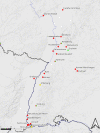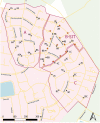Integrated control of Aedes albopictus in Southwest Germany supported by the Sterile Insect Technique
- PMID: 34983608
- PMCID: PMC8727083
- DOI: 10.1186/s13071-021-05112-7
Integrated control of Aedes albopictus in Southwest Germany supported by the Sterile Insect Technique
Erratum in
-
Correction: Integrated control of Aedes albopictus in Southwest Germany supported by the Sterile Insect Technique.Parasit Vectors. 2022 Feb 18;15(1):60. doi: 10.1186/s13071-022-05177-y. Parasit Vectors. 2022. PMID: 35183228 Free PMC article. No abstract available.
Abstract
Background: The invasive species Aedes albopictus, commonly known as the Asian tiger mosquito, has undergone extreme range expansion by means of steady introductions as blind passengers in vehicles traveling from the Mediterranean to south-west Germany. The more than 25 established populations in the State of Baden-Württemberg, Palatine and Hesse (south-west Germany) have become a major nuisance and public health threat. Aedes albopictus deserves special attention as a vector of arboviruses, including dengue, chikungunya and Zika viruses. In Germany, Ae. albopictus control programs are implemented by local communities under the auspices of health departments and regulatory offices.
Methods: The control strategy comprised three pillars: (i) community participation (CP) based on the elimination of breeding sites or improved environmental sanitation, using fizzy tablets based on Bacillus thuringiensis israelensis (fizzy Bti tablets; Culinex® Tab plus); (ii) door-to-door (DtD) control by trained staff through the application of high doses of a water-dispersible Bti granular formulation (Vectobac® WG) aimed at achieving a long-lasting killing effect; and (iii) implementation of the sterile insect technique (SIT) to eliminate remaining Ae. albopictus populations. Prior to initiating large-scale city-wide treatments on a routine basis, the efficacy of the three elements was evaluated in laboratory and semi-field trials. Special emphasis was given to the mass release of sterile Ae. albopictus males.
Results: More than 60% of the local residents actively participated in the first pillar (CP) of the large-scale control program. The most effective element of the program was found to be the DtD intervention, including the application of Vectobac® WG (3000 ITU/mg) to potential breeding sites (10 g per rainwater container, maximum of 200 l = maximum of approx. 150,000 ITU/l, and 2.5 g per container < 50 l) with a persistence of at least 3 weeks. In Ludwigshafen, larval source management resulted in a Container Index for Ae. albopictus of < 1% in 2020 compared to 10.9% in 2019. The mean number of Aedes eggs per ovitrap per 2 weeks was 4.4 in Ludwigshafen, 18.2 in Metzgergrün (Freiburg) (SIT area) and 22.4 in the control area in Gartenstadt (Freiburg). The strong reduction of the Ae. albopictus population by Bti application was followed by weekly releases of 1013 (Ludwigshafen) and 2320 (Freiburg) sterile Ae. albopictus males per hectare from May until October, resulting in a high percentage of sterile eggs. In the trial areas of Ludwigshafen and Frieburg, egg sterility reached 84.7 ± 12.5% and 62.7 ± 25.8%, respectively; in comparison, the natural sterility in the control area was 14.6 ± 7.3%. The field results were in line with data obtained in cage tests under laboratory conditions where sterility rates were 87.5 ± 9.2% after wild females mated with sterile males; in comparison, the sterility of eggs laid by females mated with unirradiated males was only 3.3 ± 2.8%. The overall egg sterility of about 84% in Ludwigshafen indicates that our goal to almost eradicate the Ae. albopictus population could be achieved. The time for inspection and treatment of a single property ranged from 19 to 26 min depending on the experience of the team and costs 6-8 euros per property.
Conclusions: It is shown that an integrated control program based on a strict monitoring scheme can be most effective when it comprises three components, namely CP, DtD intervention that includes long-lasting Bti-larviciding to strongly reduce Ae. albopictus populations and SIT to reduce the remaining Ae. albopictus population to a minimum or even to eradicate it. The combined use of Bti and SIT is the most effective and selective tool against Ae. albopictus, one of the most dangerous mosquito vector species.
Keywords: Aedes albopictus; Bacillus thuringiensis israelensis; Distribution; Germany; Integrated control; Sterile insect technique.
© 2021. The Author(s).
Conflict of interest statement
The authors declare that they have no competing interests.
Figures







References
-
- Becker N, Pluskota B, Kaiser A, Schaffner F. Exotic mosquitoes conquer the world. In: Mehlhorn H, editor. Parasitology research monographs 3. Berlin: Springer; 2012. pp. 31–60.
-
- European Centre for Disease Prevention and Control (ECDC). Guideline for the surveillance of invasive mosquitoes in Europe. Stockholm: ECDC; 2012. https://www.ecdc.europa.eu/sites/default/files/media/en/publications/Pub.... Accessed 28 Dec 2021.
-
- European Centre for Disease Prevention and Control and European Food Safety Authority. Mosquito maps [internet]. Stockholm: ECDC; Aedes albopictus-current known distribution. 2021. https://ecdc.europe.eu/en/publications-aedes-albopictus-current-known-di.... Accessed 28 Dec 2021.
MeSH terms
LinkOut - more resources
Full Text Sources
Miscellaneous

